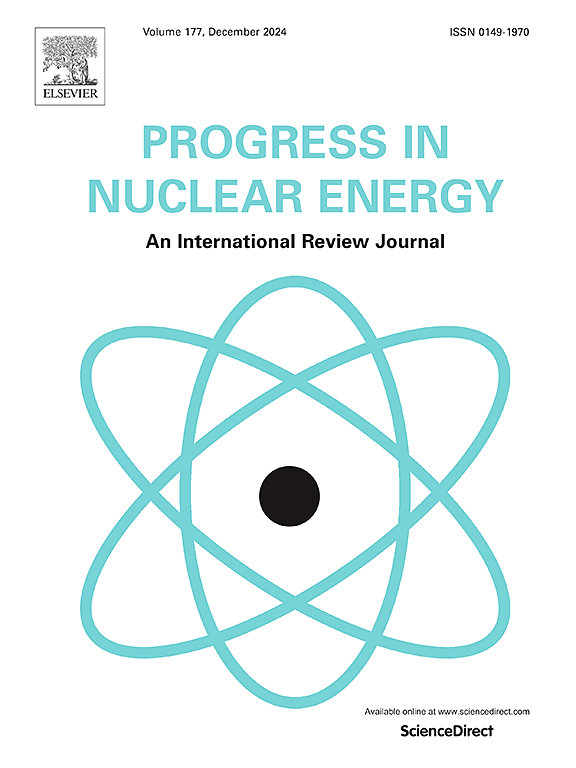Classification of radioactive material release timing for emergency preparedness
IF 3.2
3区 工程技术
Q1 NUCLEAR SCIENCE & TECHNOLOGY
引用次数: 0
Abstract
Following the Fukushima accident in 2011, concerns about nuclear accident risk and consequence management and emergency response intensified. For such severe conditions, promptly implementing a proper emergency response and effectively minimizing the impact on the public and environment is essential. To model it efficiently, a number of elements must be taken into account. In particular, the release starting time after the initiating event and the release behavior characteristics of radioactive materials (e.g., Cs-137) are essential for accurate modeling. In the radiological emergency plan, a conservative estimate for the release starting time of 4 h is assigned in the emergency actions for the public. However, for specific NPPs, the characteristics of the release starting times and Cs-137 release points in each accident are different. Therefore, to construct proper radiological emergency plans for specific NPPs, this study aimed to cluster the proper ranges of release starting times and estimate the confidential Cs-137 release points under the uncertainty analysis scheme of the Optimized Power Reactor-1000 (OPR-1000) during a station blackout (SBO) and Total Loss Of Component Cooling Water (TLOCCW) accident using the Dirichlet process mixture clustering approach. As a result, the SBO scenario having the long range of release starting time showed the highest Cs-137 release in the range of 11–19 h which could help provide more flexible emergency actions and timelines. The TLOCCW scenario showed the overall short range of release starting time already agreed with the conservative estimation at 4 h to consider as the priority of the radiological emergency plan and the decision making.
应急准备放射性物质释放时间分类
2011年福岛核事故发生后,人们对核事故风险和后果管理以及应急反应的关注加剧。在如此严峻的情况下,及时实施适当的应急措施,有效地减少对公众和环境的影响至关重要。为了有效地建立模型,必须考虑许多因素。特别是,起始事件后的释放开始时间和放射性物质(如Cs-137)的释放行为特征对于准确建模至关重要。在放射性应急计划中,对公众的应急行动中,对开始释放时间的保守估计为4小时。然而,对于特定的核电站,每次事故的释放开始时间和Cs-137释放点的特征是不同的。因此,为了构建适合特定核电厂的辐射应急预案,本研究旨在采用Dirichlet过程混合聚类方法,在核电站停电(SBO)和组件冷却水完全损失(TLOCCW)事故的不确定性分析方案下,对启动释放时间的合适范围进行聚类,并估计机密Cs-137释放点。因此,具有较长释放起始时间范围的SBO情景显示,11-19小时范围内的Cs-137释放量最高,这有助于提供更灵活的应急行动和时间表。TLOCCW情景表明,释放起始时间的总体短范围已经与4小时的保守估计一致,可以作为放射应急计划和决策的优先考虑。
本文章由计算机程序翻译,如有差异,请以英文原文为准。
求助全文
约1分钟内获得全文
求助全文
来源期刊

Progress in Nuclear Energy
工程技术-核科学技术
CiteScore
5.30
自引率
14.80%
发文量
331
审稿时长
3.5 months
期刊介绍:
Progress in Nuclear Energy is an international review journal covering all aspects of nuclear science and engineering. In keeping with the maturity of nuclear power, articles on safety, siting and environmental problems are encouraged, as are those associated with economics and fuel management. However, basic physics and engineering will remain an important aspect of the editorial policy. Articles published are either of a review nature or present new material in more depth. They are aimed at researchers and technically-oriented managers working in the nuclear energy field.
Please note the following:
1) PNE seeks high quality research papers which are medium to long in length. Short research papers should be submitted to the journal Annals in Nuclear Energy.
2) PNE reserves the right to reject papers which are based solely on routine application of computer codes used to produce reactor designs or explain existing reactor phenomena. Such papers, although worthy, are best left as laboratory reports whereas Progress in Nuclear Energy seeks papers of originality, which are archival in nature, in the fields of mathematical and experimental nuclear technology, including fission, fusion (blanket physics, radiation damage), safety, materials aspects, economics, etc.
3) Review papers, which may occasionally be invited, are particularly sought by the journal in these fields.
 求助内容:
求助内容: 应助结果提醒方式:
应助结果提醒方式:


